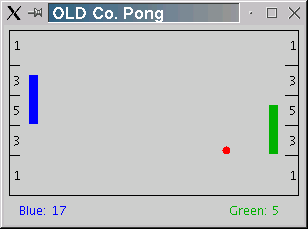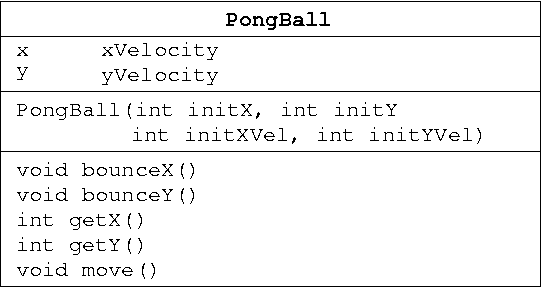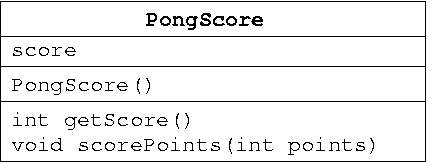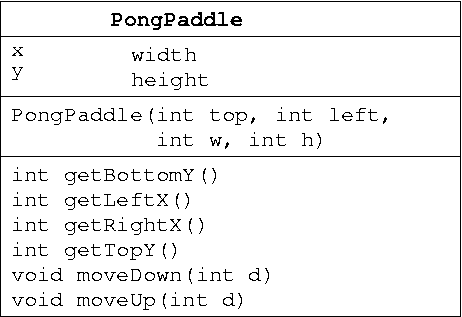Computer Science 132
Introduction To Computing II
Dickinson College
Spring Semester 2003
Grant Braught
Lab #5 - Pong!
Introduction:
You have just been hired by the Object-Oriented Language Development Company (OLD Co.) They have begun development of what they believe to be a radically new computer game, with the wholly original name of Pong. Figure 1 shows a picture of the OLD Co. Pong game:

Pong is a two player game in which each player attempts to prevent the pong-ball from reaching the wall behind his pong-paddle. A player deflects the pong-ball before it reaches the wall by placing his pong-paddle into path of the pong-ball. This causes the ball to bounce off of the paddle in the opposite direction. If the ball reaches the wall behind a player's paddle, the opponent scores. The number of points scored is dependent on the region of the wall contacted by the ball. The closer to the center of the wall the greater the number of points scored.
The high-paid software engineers at OLD Co. have spent years designing the Pong program. They have identified the classes that describe the objects the program will use. They have carefully defined the public interfaces of each of the objects. The specifications for these classes were handed off to the programmers who completed the majority of the implementation. However, just before the project was completed, all of the programmers were offered huge salaries by start-up dot com companies and simply quit on the spot! In exchange for a big check I agreed to write these classes for OLD Co. But being, ever the educator, I decided that writing these classes would be a good experience for you. Of course, I keep the check from OLD Co!
The remainder of this lab describes how to get setup to complete the Pong game and the details of the classes you must write.
Setup:
Assignment:
Your assignment is to write and test three classes that are missing from the Pong game. These classes are the PongScore, PongPaddle and PongBall classes.
The PongBall Class:
Description:
The PongBall class describes the object which the Pong application uses to represent the ball that bounces around the screen. The following class diagram illustrates the information and operations that are defined by the PongBall class.

When the Pong application is executed it creates a new PongBall object that is positioned at the center of the playing field. Approximately every 10th of a second the Pong application calls the move() method on its PongBall object causing the ball to update its position. Following the call to move() the Pong application uses the getX() and getY() methods to find the new location of the ball. If the Pong application determines that the ball would have collided with a wall or a paddle it will invoke the bounceX() or the bounceY() method to change the horizontal or vertical direction of the ball. Finally, the Pong application will draw the ball on the screen at its new location and the process will be repeated again in another 10th of a second.
Implementation:
Implement the PongBall class in the file PongBall.java in your lab5 directory (Note: not in your lab5/Pong directory!)
To implement the PongBall class you will need to define instance data for the x and y position of the ball as well as the velocity of the ball in the x and y directions. Additional information about the constructors and instance methods of the PongBall class can be found in the Java Documentation for the PongBall class. Your implementation of the PongBall class must meet the specifications given in the Java Documentation, so please study it carefully.
Testing:
One way to test the PongBall class would be to add it to the Pong application and see if the ball begins moving correctly. However, because we do not know precisely how the Pong application uses the PongBall class, it would be very difficult to determine simply by watching the Pong application if the PongBall class behaves correctly in every situation. Thus, before adding the PongBall class to the Pong application we will test its behavior independently.
To test the PongBall class you will need to write a class named PongBallTest that contains a main method. The main method in the PongBallTest class should create several PongBall objects and test their instance methods. For example, the following snippet of code will create a PongBall object and test the getX(), getY() and move() methods:
public class PongBallTest {
public static void main(String[] args) {
PongBall ball = new PongBall(10,20,2,4);
System.out.println("x should be 10, x is: " + ball.getX());
System.out.println("y should be 20, y is: " + ball.getY());
ball.move();
System.out.println("x should be 12, x is: " + ball.getX());
System.out.println("y should be 24, y is: " + ball.getY());
ball.move();
System.out.println("x should be 14, x is: " + ball.getX());
System.out.println("y should be 28, y is: " + ball.getY());
}
}
Notice that the output of the test program indicates both the correct values and the actual values that are computed. Writing your test programs in this way makes it easy to tell if the class you are testing is working correctly.
You will need to add additional code to the PongBallTest class to test the bounceX() and bounceY() methods.
Integration:
Once you have fully tested your PongBall class you can
integrate it into the Pong application. To integrate your
PongBall into the Pong application copy the
PongBall.class file from your lab5 directory
into your lab5/Pong directory.
Now when you execute the instruction java Pong & the Pong application will run using your PongBall class. When the Pong window appears, press the "B" key on the keyboard and the ball should begin bouncing around the playing field.
The PongScore Class:
Description:
The PongScore class describes the object that the Pong application uses to keep track of the score for each player. The following class diagram illustrates the information and operations that are defined by the PongScore class.

When the Pong application is executed it creates two PongScore objects, one for the blue player and one for the green player. Each time the ball contacts the end wall behind the blue paddle, the scorePoints(...) method of the green player's PongScore object is invoked, and vice versa. When invoking the scorePoints(...) method, the Pong application passes it an argument corresponding to the number of points indicated in the region of the wall that was contacted. The Pong application will then invoke the getScore() method to determine the score to be displayed beside the player's name below the playing field.
Implementation:
Testing:
To test the PongScore class write a class named PongScoreTest that contains a main method. Your PongScoreTest program should use a format similar to that used in PongBallTest. Be sure to create several PongScore objects and to call the scorePoints(...) method with several different arguments.
Integration:
Once you have fully tested your PongScore class you can integrate it into the Pong application by copying the PongScore.class file from your lab5 directory into your lab5/Pong directory.
When you run the Pong application and press the "B" key, the ball will again begin to bounce around the playing field. However, now each time the ball contacts the end wall the opponent's score will be incremented by the appropriate number of points.
The PongPaddle Class:
Description:
The PongPaddle class describes the objects that the Pong application uses to keep track of the size and location of the pong paddles. The following class diagram illustrates the the information and operations that are defined by the PongPaddle class:

When the Pong application is run it creates two new PongPaddle objects: one for the blue player positioned at the left end of the playing field, the other for the green player positioned at the right end of the playing field. When the blue player presses the "A" key, the Pong application invokes the moveUp(...) method of the blue player's PongPaddle object. Conversely, when the blue player presses the "Z" key the Pong application invokes the moveDown(...) method. Similar actions are taken using the green player's PongPaddle object when the "M" and "K" keys are pressed. The Pong application then uses the getLeftX(), getTopY(), getRightX() and getBottomY() methods to determine where on the screen the blue and green paddles should be drawn. These methods are also used by the Pong application to determine when the ball collides with one of the paddles.
Implementation:
Implement the PongPaddle class in the file PongPaddle.java in your lab5 directory. Your implementation must meet the specifications given in the Java Documentation for the PongPaddle class.
Bonus [+5 pts.]: Implement the PongPaddle class using a java.awt.Rectangle object for instance data instead of the four values shown in the class diagram. Note: the public interface of the PongPaddle class must not change.
Testing:
To test the PongPaddle class write a class named PongPaddleTest that contains a main method. Your PongPaddleTest program should use a format similar to that used in PongBallTest. Be sure to create several PongPaddle objects and to call all of the instance methods several several times with several different arguments (when appropriate).
Integration:
Once you have tested your PongPaddle class you can integrate it into the Pong application by copying the PongPaddle.class file from your lab5 directory into your lab5/Pong directory.
When the Pong application is run, pressing the "B" key begins the ball bouncing as before. However, now when the "A" or "Z" keys are pressed the blue paddle will move up or down. Similarly, when the "K" or "M" keys are pressed the green paddle will move up or down.
Congratulations! You now have a complete working Pong application!
Grading
This lab will be worth 50 points. The PongScore, PongPaddle and PongBall classes will be worth 11 points each. Your score for each program will be determined by the correctness of its execution as well as its formatting and readability. The programs in the PongScoreTest.java, PongPaddleTest.java and PongBallTest.java files will be worth 5 points each. These programs will be scored based on their ability too test each of the objects completely, as well as their formatting and readability. (That's 48 points, so 2 points for your name!)
On the due date for this lab, you must hand in a printout of the following files:
PongScore.java
PongScoreTest.java
PongPaddle.java
PongPaddleTest.java
PongBall.java
PongBallTest.java
These files must also appear in your cs132/lab5 directory.
When writing your programs please be sure to pay attention to the following readability and maintainability issues:
- Align and indent your code following the examples in the text or on the course web pages.
- Use blank lines in your code as clues to the reader that indicate logically distinct parts of your program.
- Choose descriptive names for your variables.
- Use comments to describe the role of statements in solving the problem if it is not obvious from the Java code itself.
- Use constants instead of "magic numbers."
- Name your variables and constants using the Java naming conventions we discussed in class.



